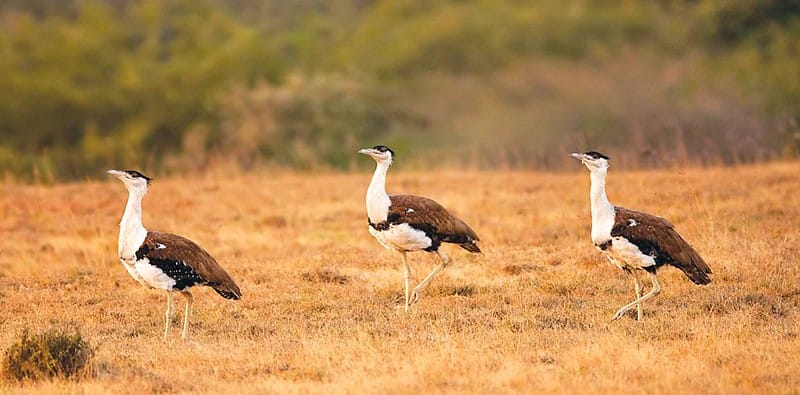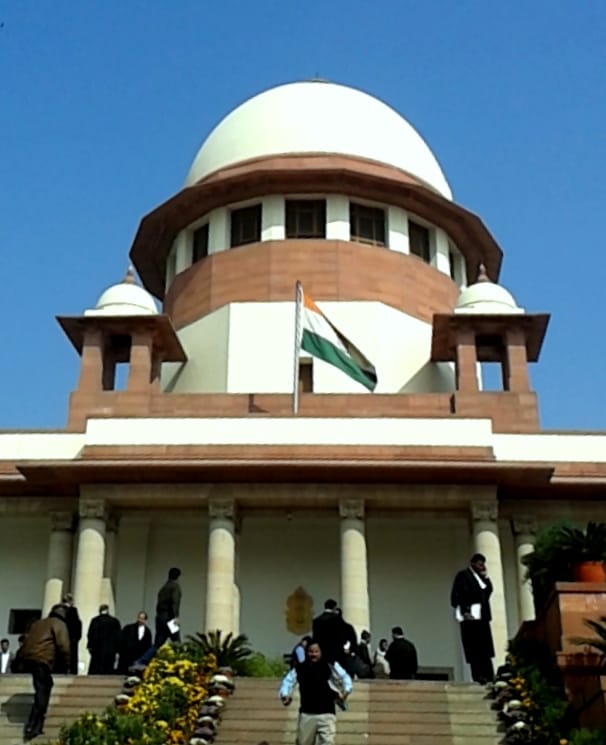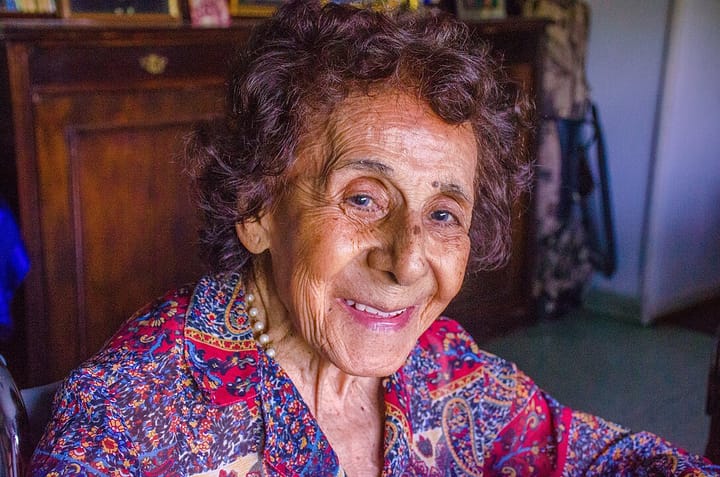Inglorious bustards: How an endangered bird could reshape climate justice in India

The Great Indian Bustard is an unassuming bird despite its size, dressing like a dowdy office worker and holding its long neck with a permanently alert-looking tilt. It once roamed across most of north-western and west-central India, but is now critically endangered and can only be found in the states of Rajasthan and Gujarat.
This bird’s massive decline in numbers - now at around just 200 individuals - is mainly due to loss and degradation of its habitat, as well as hunting for sport and food. But it is also at risk from the construction of infrastructure, such as roads, wind turbines, solar energy projects and electricity pylons.
In recent months, the Great Indian Bustard has become the unsuspecting subject of a landmark ruling by the Supreme Court of India that seeks to balance the need to tackle climate change, promote energy security and maintain biodiversity - and recognises that some have more to lose from this equation.
Overhead power lines
The original case was brought by MK Ranjitsinh, a well-known Indian conservationist. Concerned about the plight of the Great Indian Bustard, as well as its smaller cousin the Lesser Florican, Ranjitsinh succeeded in 2021 in getting a court order blocking the installation of overhead transmission lines over a wide area and mandating that they be dug underground instead.
Viewing such an order as impractical, the central Indian government appealed.
To explain how important the court’s recent ruling is, let’s roll back a bit.
India has had a number of lawsuits with a climate flavour, as outlined by lawyer and academic Shibani Ghosh, where people have challenged the climate impacts of government decisions or its inability to regulate specific activities, or sought to force public bodies to comply with the law.
One key case was brought by then nine-year-old Ridhima Pandey against the Indian government before the National Green Tribunal - the court that takes most high-level environment and development complaints. She argued that her rights were being violated and the state should do more to mitigate its emissions.
Pandey’s petition was dismissed in 2019, on the grounds that climate change was already covered in the impact assessment process, leading commentators to note that it did not engage with the case’s core issues.
But there have been successes. In a case brought by lawyer and activist Nuggehalli Jayasimha against the government, the National Green Tribunal examined the climate impact of dairy farming and subsequently directed the central pollution control board to develop a methane inventory for dairies throughout India and set sustainability guidelines for the industry.
Gita Gill, professor of environmental law at Northumbria Law School, says climate consciousness is also evident in forest-related rulings.
There have even been lawsuits where the government has defended a policy decision with reference to climate change; for example a decision to increase licence fees on timber on the grounds that deforestation is responsible for significant greenhouse gas emissions.
However, climate litigation is still commonly referred to as a ‘nascent’ field in India. Despite being the world’s most populous country and one at high risk from climate change, India hosts just 0.5% of cases in the Sabin Centre’s database.
“Avoiding an emission-based framing in India is arguably part of the tactical litigation strategy”
One clear reason for this is because India has not passed a climate law on which to pin litigation.
But it is also because, in common with other countries across the Global South, campaigners have tended to avoid focusing on emissions as part of their legal strategies.
In a new paper published in Carbon & Climate Law Review, law PhD candidate at KU Leuven Parul Kumar notes that concerns around climate change have remained secondary to environmental issues of a more “mainstream nature”, such as environmental impact assessment, forestry and air pollution.
Air pollution cases, for example, are often framed in terms of their direct effect on human health rather than the more diffuse impacts of greenhouse gas emissions. And the arguments are usually localised rather than nationwide.
India is a growing economy with real development concerns, writes Ghosh, so it is unsurprising that climate change is a peripheral issue in most cases.
A 'stealth' strategy
Kumar notes that even the National Action Plan on Climate Change and its state counterparts are framed around co-benefits, where climate change is tackled alongside meeting the country’s other pressing development needs. So rather than focusing on emission reduction obligations, the narrative seeks to promote renewable energy.
The result, writes Kumar, is a “stealth strategy” aimed at combining climate change issues with claims that are less controversial. “Avoiding an emission-based framing in India is arguably part of the tactical litigation strategy.”
In common with academics writing about the African continent, Kumar argues for a broader view of what climate litigation is and could be, which recognises how climate change affects human well-being, health and livelihoods. “It would be a very narrow view to take that this is not the case simply because the term ‘emissions’ is not found in the text of legal pleadings or oral arguments in court that the case does not pertain to emissions,” she tells The Wave.
A report on corporate climate legal tactics in India, part of the British Institute of International and Comparative Law’s recently launched Global Climate Litigation Toolbox, lists a whole variety of cases, many of which do not explicitly discuss climate change.
What has happened in India is that plaintiffs have sought environmental protection through reference to constitutional rights - and courts have proved willing to accept these arguments. The fundamental right to life set out in article 21 of the constitution, for example, has often been invoked to mean the right to a clean environment and water.
In the absence of the “legislative anchor” of a climate law, says Kumar, “the reliance on environmental constitutional law jurisprudence in India is of increased strategic importance”.

That could now be about to go much further.
In the latest case, the Supreme Court expanded the concept of the right to life to include the "adverse effects of climate change". “Without a clean environment which is stable and unimpacted by the vagaries of climate change, the right to life is not fully realised,” says the ruling.
It notes that the right to health - a key part of the right to life - is affected by air pollution, shifts in vector-borne diseases, rising temperatures, droughts, shortages in food supplies due to crop failure, storms, and flooding, all of which are made worse by climate change. “From these, it emerges that there is a right to be free from the adverse effects of climate change.”
Such a right exists even without a specific climate law, this court states.
The judgment singles out solar energy, which relies on the power lines that are one threat to the bustards, as a “pivotal solution” in the global clean energy transition that will help address climate change. “Clean energy aligns with the human right to a healthy environment, as first recognised by the UN Special Rapporteur on Human Rights and the Environment in 1994”.
Vulnerable groups
Kumar says this is a landmark judgment for discussing climate change so comprehensively and directly - quite different from the approach in previous Indian rulings.
But it goes even further, stressing the greater vulnerability of particular groups such as the poor, women and Indigenous groups. “The inability of underserved communities to adapt to climate change or cope with its effects violates the right to life as well as the right to equality,” it says.
As well as their benefits in mitigating climate change, the Supreme Court highlights how renewables such as solar promote energy security, widen energy access and help curb air pollution, thereby improving public health and reducing healthcare costs. “The importance of prioritizing clean energy initiatives to ensure environmental sustainability and uphold human rights obligations cannot be understated,” it says.
For Dr Gill, the court’s references to women’s specific vulnerabilities are truly ground-breaking. “Unequal energy access disproportionately affects women and girls due to their gender roles and responsibilities such as through time spent on domestic chores and unpaid care work,” the judgment states.
“In many years of my research I've never, ever read the issue of gender being addressed this way,” says Dr Gill. “I think that is really a powerful message, which brings in both social equity and economic development.”
Media reports suggest the ruling “could energise climate litigation in India”, and experts expect to see it referred to in future cases to make more explicit arguments on climate change mitigation and adaptation. However, India may need an accompanying improvement in attribution science for these cases to succeed.
What’s particularly interesting here is the role the court itself plays, since Ranjitsinh’s original writ petition did not once mention climate change.
An article in the Indian Express says the court saw it as “necessary to carve out the right to be protected against its adverse effects as a distinct right in itself”.
It is also noteable that the ruling refers explicitly to India's international obligations, and it references climate litigation around the world, such as the Urgenda decision in the Netherlands.
"A right to environment has been in existence in India since the 1980s, but it's still one of the most polluted countries in the world"
While the judgment gives the impression that the Supreme Court went the extra mile to uphold a climate right, Kumar notes that there has been some scepticism about how enforceable it will be. It's worth adding that the Supreme Court and the National Green Tribunal have previously been accused of judicial activism when tackling environmental cases (although claims that their rulings cost the public a lot appear misleading).
Gill agrees that implemention will be difficult. “A right to environment has been in existence in India since the 1980s, but it's still one of the most polluted countries in the world.”
Nor does Kumar think the ruling replaces the urgent need for climate legislation, which no major parties in the ongoing general election have pledged to introduce. Gill thinks a climate law is unlikely in India any time soon, but she sees potential for one focused on energy that could spark litigation in support of renewables.
It is certainly not the last time the Supreme Court will consider climate change. It is currently considering a plea seeking an assessment of the carrying capacity of the Himalayan region, in terms of climate as well as tourism, vehicular traffic, scarcity of ground and surface water, and impact on air, water, trees, forests and biodiversity.
All this seems a long way away from bustards roaming the Indian grasslands, and some conservationists have voiced concerns that the judgment’s emphasis on human rights could overshadow the rights of vulnerable species.
One immediate outcome of the case is the setting up of a committee to come up with ways to balance bustard conservation and India’s sustainable development goals. Its first report is due in the summer.
The court, for its part, recognises that this is a difficult balance to get right. “Beyond mere adherence to international agreements,” it states, “India’s pursuit of sustainable development reflects the complex interplay between environmental conservation, social equity, economic prosperity and climate change.”



